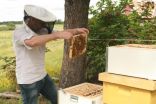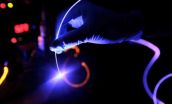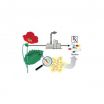(Press-News.org) CLEVELAND, Ohio (Tuesday, August 19, 2014)—Talking about genital, sexual, and urinary problems can be uncomfortable for postmenopausal women and their doctors. Having a term that doesn't carry stigma, isn't embarrassing to say, and is medically accurate could go a long way in helping women get the help they need and allowing them to make smarter healthcare decisions. That term is "genitourinary syndrome of menopause" or GSM, developed and endorsed by The North American Menopause Society (NAMS) and the International Society for the Study of Women's Sexual Health (ISSWSH). The article about the term's development is published online today in the NAMS journal Menopause.
Various terms have been used to refer to the genital problems women can have when estrogen drops after menopause, including "atrophic vaginitis" and "vulvovaginal atrophy." The first implies infection or inflammation, which isn't the main problem. The second uses "vaginal," which is embarrassing for many to say. And "atrophy" implies that something is wasting away from disuse,--a misperception that doesn't account for the many women who want to continue their sex lives free of pain after menopause. What's more, the terms ignore the urinary symptoms that come along with these genital changes, including urgency (that "gotta go" problem), painful urination, and recurring urinary tract infections.
The vagina; the area around it (the "vestibule"), which includes the urethra; and the lower end of the bladder (the "trigone") all have the same embryologic origin and are rich in estrogen receptors. The vestibule is also rich in androgen receptors. In these areas, the low hormone levels after menopause result in thinning tissue, loss of elasticity, fewer blood vessels, dryness, and physical changes that can make intercourse painful and the urethra easily irritated.
A panel of NAMS and ISSWSH menopause experts met at a consensus conference to scrutinize all that's known about the changes in these tissues after menopause and to hash out a term that fits that knowledge, doesn't stigmatize women who face these changes, and isn't embarrassing to say publicly. The panel decided the term should include both genital and urinary changes ("genitourinary"), show that it is a whole group of signs and symptoms ("syndrome"), and link the changes to their principal cause ("menopause"). With members' support, both the NAMS and ISSWSH boards endorsed the term.
Although GSM affects about half of all postmenopausal women, many don't know that it is hormonal and that treatments are available, such as vaginal moisturizers, vaginal estrogen, and an oral medication that acts like estrogen in the vagina. In addition, because women are so uncomfortable talking about these problems, only a small percentage bring them up with their healthcare providers, and only about 1 in 10 providers brings up the symptoms with patients, surveys show.
"The term 'GSM' will make discussing the problems so much easier, similar to the way 'ED' changed our ability to talk about impotence,'" says NAMS Executive Director Margery Gass, MD, a member of the consensus conference panel of NAMS and ISSWSH menopause experts.
The panelists have also begun to develop a tool to help standardize a physical examination to look for these changes. That means not only will patients and healthcare providers be able to talk about these problems more easily, but also that providers will be able to make the diagnosis swiftly and accurately to get women the treatment they need.
INFORMATION:
The article "Genitourinary Syndrome of Menopause: New Terminology for Vulvovaginal Atrophy from the International Society for the Study of Women's Sexual Health and The North American Menopause Society" will be published in the October 2014 print edition of Menopause.
Founded in 1989, The North American Menopause Society (NAMS) is North America's leading nonprofit organization dedicated to promoting the health and quality of life of all women during midlife and beyond through an understanding of menopause and healthy aging. Its multidisciplinary membership of 2,000 leaders in the field—including clinical and basic science experts from medicine, nursing, sociology, psychology, nutrition, anthropology, epidemiology, pharmacy, and education—makes NAMS uniquely qualified to serve as the definitive resource for health professionals and the public for accurate, unbiased information about menopause and healthy aging. To learn more about NAMS, visit http://www.menopause.org.
New term will banish stigma, educate providers on postmenopausal problems
'GSM' describes the genital, sexual, and urinary symptoms best
2014-08-25
ELSE PRESS RELEASES FROM THIS DATE:
'Robo Brain' will teach robots everything from the Internet
2014-08-25
ITHACA, N.Y. – Robo Brain – a large-scale computational system that learns from publicly available Internet resources – is currently downloading and processing about 1 billion images, 120,000 YouTube videos, and 100 million how-to documents and appliance manuals. The information is being translated and stored in a robot-friendly format that robots will be able to draw on when they need it.
To serve as helpers in our homes, offices and factories, robots will need to understand how the world works and how the humans around them behave. Robotics researchers have been teaching ...
Train your heart to protect your mind
2014-08-25
Exercising to improve our cardiovascular strength may protect us from cognitive impairment as we age, according to a new study by researchers at the University of Montreal and its affiliated Institut universitaire de gératrie de Montréal Research Centre. "Our body's arteries stiffen with age, and the vessel hardening is believed to begin in the aorta, the main vessel coming out of the heart, before reaching the brain. Indeed, the hardening may contribute to cognitive changes that occur during a similar time frame," explained Claudine Gauthier, first author of the study. ...
Study suggests repurposing anti-depressant medication to target medulloblastoma
2014-08-24
CINCINNATI – An international research team reports in Nature Medicine a novel molecular pathway that causes an aggressive form of medulloblastoma, and suggests repurposing an anti-depressant medication to target the new pathway may help combat one of the most common brain cancers in children.
The multi-institutional group, led by scientists at Cancer and Blood Diseases Institute (CBDI) at Cincinnati Children's Hospital Medical Center, publish their results in the journal's online edition on Aug. 24. The researchers suggest their laboratory findings in mouse models of ...
Evolutionary history of honeybees revealed by genomics
2014-08-24
In a study published in Nature Genetics, researchers from Uppsala University present the first global analysis of genome variation in honeybees. The findings show a surprisingly high level of genetic diversity in honeybees, and indicate that the species most probably originates from Asia, and not from Africa as previously thought.
The honeybee (Apis mellifera) is of crucial importance for humanity. One third of our food is dependent on the pollination of fruits, nuts and vegetables by bees and other insects. Extensive losses of honeybee colonies in recent years are a ...
Signatures of selection inscribed on poplar genomes
2014-08-24
One aspect of the climate change models researchers have been developing looks at how plant ranges might shift, and how factors such as temperature, water availability, and light levels might come into play. Forests creeping steadily north and becoming established in the thawing Arctic is just one of the predicted effects of rising global temperatures.
A recent study published online August 24, 2014 in Nature Genetics offers a more in-depth, population-based approach to identifying such mechanisms for adaptation, and describes a method that could be harnessed for developing ...
Mimicking natural evolution with 'promiscuous reactions' to improve the diversity of drugs
2014-08-24
A revolutionary new scientific method developed at the University of Leeds will improve the diversity of 'biologically active molecules', such as antibiotics and anti-cancer agents.
The researchers, who report their findings online today in the journal Nature Chemistry, took their inspiration from evolution in nature. The research may uncover new pharmaceutical drugs that traditional methods would never have found.
"Nature produces some amazing structures with really interesting biological activity, but the plant or animal did not design them. Instead the organisms ...
Study: Cutting emissions pays for itself
2014-08-24
CAMBRIDGE, Mass-- Lower rates of asthma and other health problems are frequently cited as benefits of policies aimed at cutting carbon emissions from sources like power plants and vehicles, because these policies also lead to reductions in other harmful types of air pollution.
But just how large are the health benefits of cleaner air in comparison to the costs of reducing carbon emissions? MIT researchers looked at three policies achieving the same reductions in the U.S., and found that the savings on health care spending and other costs related to illness can be big ...
Driving brain rhythm makes mice more sensitive to touch
2014-08-24
PROVIDENCE, R.I. [Brown University] — By striking up the right rhythm in the right brain region at the right time, Brown University neuroscientists report in Nature Neuroscience that they managed to endow mice with greater touch sensitivity than other mice, making hard-to-perceive vibrations suddenly more vivid to them.
The findings offer the first direct evidence that "gamma" brainwaves in the cortex affect perception and attention. With only correlations and associations as evidence before, neuroscientists have argued for years about whether gamma has an important role ...
Are you as old as what you eat? Researchers learn how to rejuvenate aging immune cells
2014-08-24
Researchers from UCL (University College London) have demonstrated how an interplay between nutrition, metabolism and immunity is involved in the process of ageing.
The two new studies, supported by the Biotechnology and Biological Sciences Research Council (BBSRC), could help to enhance our immunity to disease through dietary intervention and help make existing immune system therapies more effective.
As we age our immune systems decline. Older people suffer from increased incidence and severity of both infections and cancer. In addition, vaccination becomes less efficient ...
Stanford bioengineers close to brewing opioid painkillers without using opium from poppies
2014-08-24
For centuries poppy plants have been grown to provide opium, the compound from which morphine and other important medicines such as oxycodone are derived.
Now bioengineers at Stanford have hacked the DNA of yeast, reprograming these simple cells to make opioid-based medicines via a sophisticated extension of the basic brewing process that makes beer.
Led by Associate Professor of Bioengineering Christina Smolke, the Stanford team has already spent a decade genetically engineering yeast cells to reproduce the biochemistry of poppies with the ultimate goal of producing ...
LAST 30 PRESS RELEASES:
American College of Cardiology comments on new dietary guidelines for Americans
American Society of Gene & Cell Therapy and Orphan Therapeutics Accelerator partner to advance and commercialize promising rare disease treatments
One in 14 patients having day case surgery have new or worse chronic pain 3 months after their operation
New study highlights link between eviction rates and gun violence
Heatwaves heat up soil but not toxin levels in rice, study finds
Digital modeling reveals where construction carbon emissions really come from
Turning farm waste into water filters
New study shows how the spleen helps the immune system accept a transplant
New Mayo Clinic study advances personalized prostate cancer education with an EHR-integrated AI agent
Researchers identify novel therapeutic target to improve recovery after nerve injury
Microbes in breast milk help populate infant gut microbiomes
Reprogramming immunity to rewrite the story of Type 1 diabetes
New tool narrows the search for ideal material structures
Artificial saliva containing sugarcane protein helps protect the teeth of patients with head and neck cancer
Understanding the role of linear ubiquitination in T-tubule biogenesis
Researchers identify urban atmosphere as primary reservoir of microplastics
World’s oldest arrow poison – 60,000-year-old traces reveal early advanced hunting techniques
Bristol scientists discover early sponges were soft
New study uncovers how rice viruses manipulate plant defenses to protect insect vectors
NSF–DOE Vera C. Rubin Observatory spots record-breaking asteroid in pre-survey observations
Ribosomal engineering creates “super-probiotic” bacteria
This self-powered eye tracker harnesses energy from blinking and is as comfortable as everyday glasses
Adverse prenatal exposures linked to higher rates of mental health issues, brain changes in adolescents
Restoring mitochondria shows promise for treating chronic nerve pain
Nature study identifies a molecular switch that controls transitions between single-celled and multicellular forms
USU chemists' CRISPR discovery could lead to single diagnostic test for COVID, flu, RSV
Early hominins from Morocco reveal an African lineage near the root of Homo sapiens
Small chimps, big risks: What chimps show us about our own behavior
We finally know how the most common types of planets are created
Thirty-year risk of cardiovascular disease among healthy women according to clinical thresholds of lipoprotein(a)
[Press-News.org] New term will banish stigma, educate providers on postmenopausal problems'GSM' describes the genital, sexual, and urinary symptoms best


